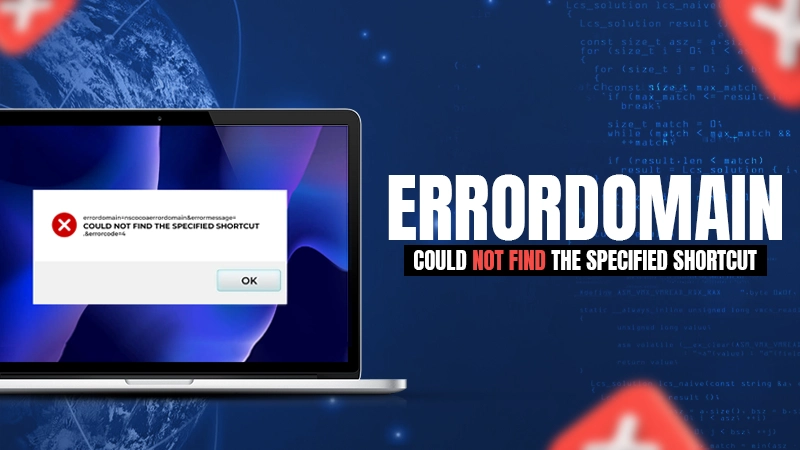In the world of technology, encountering errors while using software or operating systems is quite common, and macOS is no exception. One specific error that users may come across is “errordomain=nscocoaerrordomain&errormessage=could not find the specified shortcut.&errorcode=4.” This error message can appear when the system fails to locate a shortcut that was supposed to link to an application, file, or other resources. Although this may sound complex, understanding the root cause of the problem and the steps to fix it can make the troubleshooting process much easier.
Table of Contents
What is “errordomain=nscocoaerrordomain&errormessage=could not find the specified shortcut.&errorcode=4”?
Before diving into troubleshooting, it’s important to understand the error message. The “errordomain=nscocoaerrordomain“ part refers to the Cocoa error domain, a fundamental aspect of the macOS and iOS operating systems. This domain is responsible for handling various errors that occur within applications built using Apple’s Cocoa framework.
The “errormessage=could not find the specified shortcut” means that macOS cannot find the specific shortcut that was requested. Shortcuts in macOS are essentially pointers to applications or files, enabling quick access. When macOS cannot locate the shortcut, it produces this error.
Finally, “errorcode=4“ typically points to an issue where the system cannot access the file or application linked by the shortcut, often due to a broken link, missing file, or incorrect permissions.

Common Causes of the “errordomain=nscocoaerrordomain&errormessage=could not find the specified shortcut.&errorcode=4”
Several reasons can cause the “errordomain=nscocoaerrordomain&errormessage=could not find the specified shortcut.&errorcode=4” error. Here are the most frequent causes:
1. Broken Shortcuts
A shortcut points to a file or application. If that file or application has been moved, deleted, or is not accessible, the system will not be able to resolve the shortcut. This is one of the most common causes of the error message.
2. Incorrect File Path
The error might also occur when the target file has been moved to a different directory or renamed. If the shortcut cannot find the file at the original location, it will display the error message “could not find the specified shortcut.”
3. Permissions Issues
Sometimes, permission issues can prevent the system from accessing the target file or application. If the shortcut points to a file that is in a restricted directory, macOS may not have the necessary permissions to open the file, triggering the error.
4. Corrupted System Files
Corrupted system files, including settings related to shortcuts, can also cause this error. Damaged or inconsistent preferences might disrupt the normal operation of shortcuts on the system, leading to the “errordomain=nscocoaerrordomain&errormessage=could not find the specified shortcut.&errorcode=4” error.
5. Recent macOS Updates
Updates to macOS can sometimes alter file paths, remove applications, or change system configurations. After an update, certain shortcuts may no longer work, resulting in this error.

How to Fix “errordomain=nscocoaerrordomain&errormessage=could not find the specified shortcut.&errorcode=4”
If you’re encountering this error message on your macOS device, don’t worry. There are several troubleshooting steps you can follow to resolve the “errordomain=nscocoaerrordomain&errormessage=could not find the specified shortcut.&errorcode=4” issue.
1. Verify the Target of the Shortcut
The first step in troubleshooting is to check if the shortcut is still pointing to the correct file or application. Right-click on the shortcut and select “Get Info.” Review the location of the shortcut’s target. If the file or application has been moved or deleted, you may need to update the shortcut or create a new one pointing to the correct location.
2. Ensure the Target File Exists
Double-check that the file or application the shortcut is trying to link to actually exists on your system. If the file was accidentally deleted, you’ll need to restore it or update the shortcut to point to a valid location.
3. Check and Repair Permissions
Permissions problems can sometimes cause this error. If macOS does not have the required access to the file or application, the system won’t be able to open the shortcut. To repair disk permissions, open Disk Utility and select your primary disk. Click on “First Aid” to repair any disk errors, which might fix permission-related issues and resolve the error.
4. Clear System Caches
Sometimes, system caches can cause this issue. Caches store temporary data that speeds up system processes, but outdated or corrupted caches can lead to unexpected errors. To clear the cache on macOS, go to Finder and select Go > Go to Folder. Type ~/Library/Caches and delete the cache files related to the application or process causing the error.
5. Update macOS
After updates, certain files or applications may be moved or removed. Ensure that your system is up to date with the latest macOS version by checking for updates in the System Preferences section under Software Update. Installing any available updates might fix the problem by restoring any missing system files or resolving conflicts with shortcuts.
6. Rebuild the Spotlight Index
Spotlight is the search system used by macOS. Sometimes, if Spotlight’s index is corrupted, it can cause issues with locating files and shortcuts. To rebuild the Spotlight index, go to System Preferences > Spotlight > Privacy, then add and remove your disk from the list. This will force Spotlight to rebuild its index, which may help it find missing files or shortcuts.
7. Restore from Backup
If all else fails, restoring your system from a recent backup using Time Machine can often resolve issues related to missing shortcuts or corrupted files. This will revert your system to a point when the shortcuts were working properly.
Preventing the “errordomain=nscocoaerrordomain&errormessage=could not find the specified shortcut.&errorcode=4” Error in the Future
Once you’ve resolved the issue, it’s important to take some steps to prevent it from recurring. Here are some recommendations:
- Keep Your Shortcuts Organized: Regularly review your shortcuts and ensure they are correctly linked to their targets. If you move or rename files, be sure to update or remove shortcuts accordingly.
- Avoid Frequent System Changes: Constantly altering file paths or renaming files can lead to broken shortcuts. Try to keep file management consistent to avoid these issues.
- Perform Regular System Maintenance: Regularly check for macOS updates and clear system caches to keep your system running smoothly and avoid future errors.
- Backup Your System: Regular backups using Time Machine or other backup tools will ensure that you can recover your system to a previous state in case shortcuts or files are lost or corrupted.
Also Read: Exploring Chosenviber.net: A Comprehensive Guide to the Latest Online Messaging Platform
Conclusion
The “errordomain=nscocoaerrordomain&errormessage=could not find the specified shortcut.&errorcode=4” message can be frustrating, but understanding the causes and following the troubleshooting steps outlined above can help resolve the issue. Whether it’s broken shortcuts, file path issues, or permissions problems, taking the time to verify and repair the system will often fix the error and restore your system to working order. Keep your system updated, organized, and backed up to prevent future occurrences of this error.


